25,000 - 12,000 B.C.
Early humans decorate themselves with with shells, bone, teeth and pebbles by at least the Upper Palaeolithic period.
6000 B.C.
Carnelian and rock crystal beads have been found in what is now Iraq.
4000 B.C.
Carved quartz seals were being made.
2500 B.C.
Rome, Egypt, Greece and China all had thriving trades in gem materials (Lapis, carnelian, turquoise, quartz, and others.)
800 B.C.
Diamonds are known in India from at least this date and treasured as talisman.
800 BC - 1000 AD
Several technologies needed to polish, drill, and work stones are undergoing discovery snd refinement. Use of corundum as an abrasive (India), bamboo drills with corundum (India), diamonds are mined in India and it becomes the center of the gem trade.
There may have been faceted stone in and around Venice as early as 800 A.D., but the process was like many others of the day, and kept as a closely guarded secret in a guild or
1000 A.D.
Sometime around this date it is believed that the first faceted (stones with polished flat sides that were designed to give back light) gems may have appeared.
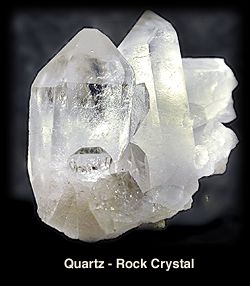
The idea for faceted stones may be related to the observation of nature and little luck. Crystals were observed in nature and occasionally a really clear one was found. It is not hard to imagine that an inquisitive person may have polished the base of a rock crystal (quartz) and discovered the reflected light from its hexagonal termination.
The next two pictures show quartz crystals that have had some (but not all sides polished) and were then cut across the base. The base was then polished and when viewed from the bottom, there is a marked resemblance to the base of a faceted stone.
The reverse side of the crystal termination is pointed somewhat like the bottom of a cut gemstone, and in this case the angle is high enough to make most of the light reflect back through the base.
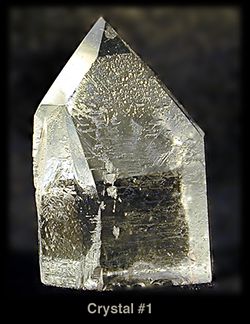
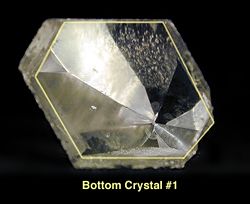
Some of the oldest "faceted" gemstones have designs based on polishing the natural faces of minerals as they were formed in nature. Sometimes just the long parallel side of a crystal were polished to remove the associated rock in which they formed.
It was known that diamond was the hardest mineral found in the early days, the name is derived from the Greek "adamas" which translates to "I tame" or "I subdue". It is because it was recognised as the hardest stone and it could scratch all others.
It was also discovered that it could be broken in 3 directions by a sharp blow. Probably due to erroneous reporting as the "hardest" of all materials, one early test was to strike a potential diamond material with a hammer, if it survived it was deemed as truly indestructible.
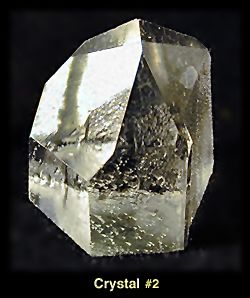
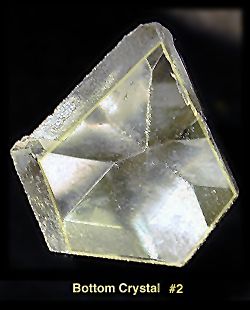
Crystalline diamond often forms in octahedral crystals. Because diamond has perfect cleavage, it will break parallel to any of its bases. If struck a glancing bow with a chisel or other knife edge in this alignment, the diamond is cleanly broken into two pieces. Of course if the knife blade is placed at the wrong angle, the diamond can also be converted to many somewhat irregular fragments.
A diamond model is shown in the first diagram below. Another model showing its perfect cleavage is shown in the second picture. Now imagine for a minute that some one cleans up the other faces (polishes them), the result is shown in the third picture, and as you can see it is actually a simple faceted stone.
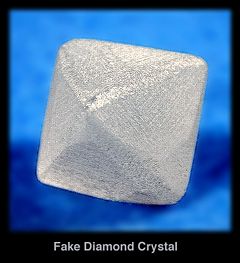
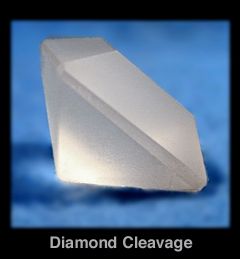
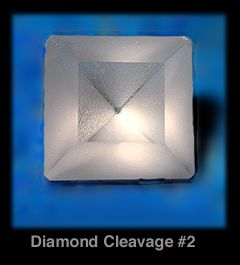
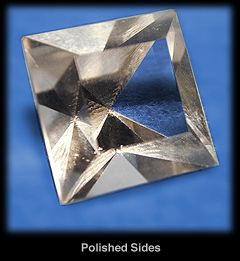
This finished stone had 9 facets and followed exactly the original crystal shape designed by nature.
With time more facets were cut and added surfaces began to appear. The earliest cuts still had few overall facets, but they added geometry and eventually lead to the 8 sided brilliant cut.
Some of the earlier cuts included the Old Single Cut 17 facets, the Mazarin Cut 33 facets,
1458 A.D.
An early variation of a round brilliant cut diamond was credited to Louis de Brugge of Belgium. (Probably the "Old Single Cut")
1650 A.D.
Addition of the "Mazarin" cut with a full 33 facets, another mile stone along the way to the True Round Brilliant.
~1700 A.D.
A venetian cutter named Vicenzio Peruzzi cut the first 58 facet stone + table (diamond), although the facets were irregular.
1910 A.D.
Around this time the modern "Brilliant Cut" was developed from many old diagrams and some experimentation, It contained 24 facets on the pavilion (bottom) and 32 facets on the crown (top) with one table facet. A total of 57 facets.
1971 A.D.
The Barion Cuts were designed by Basil Watermeyer, a diamond cutter in Johannesburg, South Africa. The concept was to find a cut that would return more "fire" in square, rectangular , and oval stones. Something more like a round brilliant.


